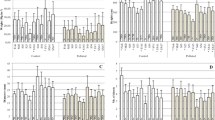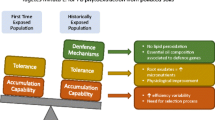Abstract
Petroleum contamination poses a significant threat to environmental ecosystems world-wide. Phytoremediation can be used to enhance degradation of petroleum contaminants in soil. However, selection of plants for phytoremediation has proven to be complicated. This research examines the heritability of the alfalfa cultivar Riley for phytoremediation based on parental total petroleum hydrocarbon (TPH) degradation after twelve months of growth. Traits other than degradation potential, such as root and shoot yield, height, and maturity, were examined for use as selection traits. Riley showed moderate to low heritability that suggests the possibility of breeding for phytoremediation efficiency. In addition, root and shoot yield were found to correlate to TPH degradation. Crosses in which the female parent was typically associated with low TPH dissipation yielded progeny that were high efficiency TPH degraders.
Similar content being viewed by others
References
Ebbs, S.D., Lasat, M.M., Brady, D.J., Cornish, J., Gordan, R., & Kochian, L.V. (1997). Phytoextraction of cadmium and zinc from a contaminated soil. Journal of Environmental Quality, 26, 1424–1430.
Fehr, W. (1991). Principle of Cultivar Development: Volume 1 and 2. New York: Macmillian Publishing Company.
Ferro, A.M., Rock, S.A., Kennedy, J., Herrick, J.J., & Turner, D. L. (1999). Phytoremediation of soils contaminated with wood preservatives: greenhouse and field evaluations. Journal of Phytochemistry, 1, 289–306.
Kalu, B.A., & Fick, G.W. (1983). Morphological stage of development as a predictor of alfalfa herbage of quality. Crop Science, 23, 1167–1172.
Kalu, B.A., & Fick, G.W. (1981). Quantifying morphological development of alfalfa for studies of herbage quality. Crop Science, 21, 267–271.
Lalande, T.L., Skipper, H.D., Wolf, D.C., Reynolds, C.M., Freedman, D.L., Pinkerton, B.W., Hartel, P.G., & Grimes, L.W. (2003). Phytoremediation of pYearene in a Cecil soil under field conditions. International Journal of Phytochemistry, 5, 1–12.
Liste, H., & Alexander, M. (1999). Plant-promoted pYearene degradation in soil. Chemosphere, 40, 7–15.
Loehr, R.C., & Webster, M.T. (1996). Performance of long-term, field-scale bioremediation processes. Journal of Hazardous Materials, 50, 105–128.
Misra, S., & Geamu, L. (1989). Heavy metal tolerant transgenic Brassica napus L. and Nicotiana tabacum L. plants. Theoretical and Applied Genetics, 78, 161–186.
Newman, L.A., Doty, S.L., Gery, K.L., Heilman, P.E., Muiznieks, I., Shang, T.Q., Siemieniec, S.T., Strand, S.E., Wang, X.P., Wilson, A.M., & Gordon, M.P. (1998). Phytoremediation of organic contaminants: A review of phytoremediation research at the University of Washington. Journal of Soil Contamination, 7, 531–542.
Reilley, K.A., Banks, M.K., & Schwab, A.P. (1996). Organic chemicals in the environment dissipation of polycyclic aromatic hydrocarbons in the rhizosphere. Journal of Environmental Quality, 25, 212–219.
Samake, M., Wu, Q.T., Mo, C.H., & Morel, J.L. (2003). Plants grown in sewage sludge in South China and its relevance to sludge stabilization and metal removal. Journal of Environmental Quality, 5, 622–627.
Schwab, A.P., Su, J., Wetzel, S., Pekarek, S., & Banks, M.K. (1999). Extraction of petroleum hydrocarbons from soil by mechanical shaking. Environmental Science and Technology, 33, 1940–1945.
Walton, B.T., & Anderson, T.A. (1990). Microbial degradation of trichloroethylene in the rhizosphere: Potential application to biological remediation of waste sites. AEM, 56, 1012– 1016.
Whiting, S.N., Leake, J.R., McGrath, S.P., & Baker, A.J. (2001). Hyperaccumulation of Zn by Thlaspi caerulescens can ameliorate Zn toxicity in the rhizosphere of co-cropped Thlaspi arvense. ES&T, 35, 3237–3241.
Wiltse, C.C., Ronney, W.L., Chen, Z., Schwab, A.P., & Banks, M.K. (1998). Greenhouse evaluation of agronomic and crude oil phytoremediation potential among alfalfa genotypes. JEQ, 27, 169–173.
Wilson, S.K., & Jones, K. (1993). Bioremediation of soil contaminated with polynuclear aromatic hydrocarbons (PAHs): A review. Environmental Pollution, 81,229–249.
Xin, X., Xiao, Y., Zheng, Q., Wu, N.Z., & Wei, Y.S. (2002). Study of the differences of uptake and acccumulation of zinc in four species of Sedum linn, Acta Botanica Sinica, 44, 152–157.
Author information
Authors and Affiliations
Corresponding author
Rights and permissions
About this article
Cite this article
Schwab, P., Banks, M.K. & Kyle, W.A. Heritability of Phytoremediation Potential for the Alfalfa CultivarRiley in Petroleum Contaminated Soil. Water Air Soil Pollut 177, 239–249 (2006). https://doi.org/10.1007/s11270-006-9161-7
Received:
Accepted:
Published:
Issue Date:
DOI: https://doi.org/10.1007/s11270-006-9161-7




